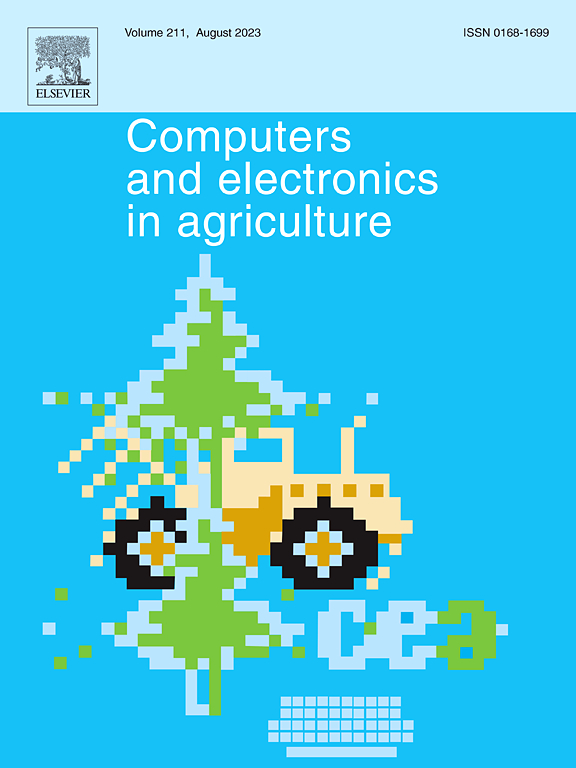Increasing yield estimation accuracy for individual apple trees via ensemble learning and growth stage stacking
IF 8.9
1区 农林科学
Q1 AGRICULTURE, MULTIDISCIPLINARY
引用次数: 0
Abstract
Accurate prediction of individual apple tree yields during the preharvest stage is essential for precision orchard management and market planning. However, systematic studies focusing on apple yield estimation are scarce. To address this gap, this study targets Fuji apples in the Aksu region of Xinjiang. Multiple images were captured via a UAV during four key growth stages: flowering, fruit formation, fruit expansion, and ripening. On the basis of the extracted vegetation indices, we first developed yield estimation models using random forest (RF), support vector regression (SVR), partial least squares regression (PLS), and ridge regression (RR) methods. We subsequently combined these four models to construct a stacking ensemble learning (SEL) model. To further increase the accuracy of apple yield estimation, we refined the growth stage stacking method and developed a new model, the growth stage stacking ensemble (GSSE). This model maximises the use of spectral information from multiple apple growth stages by employing various machine learning algorithms and integrating multistage spectral data to improve yield estimation accuracy. The results indicate that the optimal period for yield estimation occurs during the fruit expansion stage, with the support vector regression (SVR) model achieving the best performance (R2 = 0.654, RMSE = 5.307 kg). Compared with individual machine learning models, the SEL approach enhances yield estimation accuracy, reaching a maximum R2 of 0.686 and an RMSE of 5.058 kg. Furthermore, GSSE significantly enhanced accuracy compared with the single-growth stage estimation models and SEL, with the combination of fruit expansion and fruit ripening stages yielding the best results, with an R2 of 0.759 and an RMSE of 4.431 kg, with the fruit expansion stage contributing the most. This study is the first to apply the GSSE to apple yield estimation, offering novel insights for UAV-based apple yield estimation.

通过集成学习和生育期叠加提高单株苹果产量估算精度
采前阶段对单株苹果树产量的准确预测对果园的精准管理和市场规划至关重要。然而,针对苹果产量估算的系统研究却很少。为了解决这一差距,本研究以新疆阿克苏地区的富士苹果为研究对象。无人机在四个关键生长阶段拍摄了多幅图像:开花、果实形成、果实膨胀和成熟。在提取植被指数的基础上,我们首先利用随机森林(RF)、支持向量回归(SVR)、偏最小二乘回归(PLS)和岭回归(RR)方法建立了产量估计模型。随后,我们将这四个模型结合起来构建了一个堆叠集成学习(SEL)模型。为了进一步提高苹果产量估算的精度,对生长期叠加法进行了改进,建立了生长期叠加集合(GSSE)模型。该模型通过采用各种机器学习算法和整合多阶段光谱数据,最大限度地利用来自多个苹果生长阶段的光谱信息,以提高产量估计的准确性。结果表明,果实膨大期为估算产量的最佳时期,其中支持向量回归(SVR)模型的估算效果最佳(R2 = 0.654, RMSE = 5.307 kg)。与单个机器学习模型相比,SEL方法提高了产量估计精度,最大R2为0.686,RMSE为5.058 kg。与单生长期估算模型和SEL相比,GSSE显著提高了预测精度,其中果实膨大期和果实成熟期组合估算结果最好,R2为0.759,RMSE为4.431 kg,其中果实膨大期贡献最大。本研究首次将GSSE应用于苹果产量估算,为基于无人机的苹果产量估算提供了新的见解。
本文章由计算机程序翻译,如有差异,请以英文原文为准。
求助全文
约1分钟内获得全文
求助全文
来源期刊

Computers and Electronics in Agriculture
工程技术-计算机:跨学科应用
CiteScore
15.30
自引率
14.50%
发文量
800
审稿时长
62 days
期刊介绍:
Computers and Electronics in Agriculture provides international coverage of advancements in computer hardware, software, electronic instrumentation, and control systems applied to agricultural challenges. Encompassing agronomy, horticulture, forestry, aquaculture, and animal farming, the journal publishes original papers, reviews, and applications notes. It explores the use of computers and electronics in plant or animal agricultural production, covering topics like agricultural soils, water, pests, controlled environments, and waste. The scope extends to on-farm post-harvest operations and relevant technologies, including artificial intelligence, sensors, machine vision, robotics, networking, and simulation modeling. Its companion journal, Smart Agricultural Technology, continues the focus on smart applications in production agriculture.
 求助内容:
求助内容: 应助结果提醒方式:
应助结果提醒方式:


